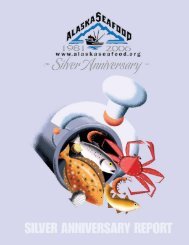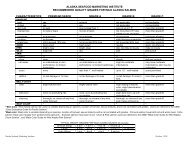w salmon caviar - Alaska Seafood Marketing Institute
w salmon caviar - Alaska Seafood Marketing Institute
w salmon caviar - Alaska Seafood Marketing Institute
You also want an ePaper? Increase the reach of your titles
YUMPU automatically turns print PDFs into web optimized ePapers that Google loves.
S U J I K OTraditional Japanese sujiko features salted and cured <strong>Alaska</strong> <strong>salmon</strong> roe withinthe natural membrane or film (in-sac). Sujiko is a Japanese word composedof “suji,” which means “line,” and “ko,” which means “child.” The name refers tothe way in which the eggs are lined up in the ovary. The raw egg sacs are washedin a saturated brine solution, drained, packed with salt and then allowed to cure.Grading InformationTypically, there are three standard grades of sujiko: No.1, No.2 and No.3, plus“off-grade” which includes roe that is cut, broken, soft, or off-color. In general,high-grade sujiko usually follow these guidelines:• Eggs are large in size for the species• Color is bright and uniform throughoutthe sac• Eggs are firm and fresh at a balancedmaturity level, neither too oldnor immature• Surface membranes are strong yetsoft with the sac intact and with eggsarranged in neat linesLower grades of sujiko are well suitedfor the production of <strong>salmon</strong> roe spreads,pâtés and butters.<strong>Alaska</strong> <strong>salmon</strong> sujiko can be purchased as salted sujiko, soy-marinated sujiko,or as frozen unprocessed roe. Packaging typically includes origin, importer contactinformation, and will state whether or not the product is lower in salt content oruses a salt substitute.Producers have their own specifications, so it is important for buyers to workclosely with their suppliers.








